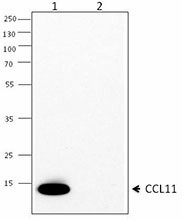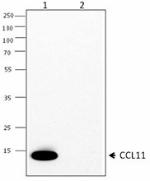- Clone
- 16D10A40 (See other available formats)
- Regulatory Status
- RUO
- Other Names
- Eotaxin-1, small inducible cytokine subfamily A, member 11 (SCYA11)
- Isotype
- Rat IgG2a, κ
- Ave. Rating
- Submit a Review
- Product Citations
- publications

-

Western blot analysis of recombinant human CCL11(lane 1) and recombinant mouse CCL11 (lane 2) using anti-CCL11 antibody(16D10A40).
| Cat # | Size | Price | Quantity Check Availability | Save | ||
|---|---|---|---|---|---|---|
| 656701 | 500 µg | 235€ | ||||
CCL11 is a member of the CC chemokine family and was originally identified as a chemoattractant for eosinophils. In response to allergens, CCL11, which participates in a variety of allergic diseases, promotes accumulation of eosinophils. CCL11 production is upregulated in response to several proinflammatory cytokines, such as IL-4, IL-13, TNF-α, and IFN-α, produced by mast cells and Th2 lymphocytes. CCL11 has been reported to stimulate eosinophil release from bone marrow, resulting in an elevated level of circulating eosinophils. In addition, CCL11 facilitates proliferation and metastasis of tumor cells expressing the CCL11 receptor, CCR3. CCL11 has been shown to induce an angiogenic response by CCR3-positive microvascular endothelial cells.
Product DetailsProduct Details
- Verified Reactivity
- Human
- Antibody Type
- Monoclonal
- Host Species
- Rat
- Immunogen
- Human CCL11 recombinant protein (Gly24-Pro97) expressed in E. coli
- Formulation
- Phosphate-buffered solution, pH 7.2, containing 0.09% sodium azide.
- Preparation
- The antibody was purified by affinity chromatography.
- Concentration
- 0.5 mg/ml
- Storage & Handling
- The antibody solution should be stored undiluted between 2°C and 8°C.
- Application
-
WB - Quality tested
- Recommended Usage
-
Each lot of this antibody is quality control tested by Western blotting. For Western blotting, the suggested use of this reagent is 0.5 - 2.0 µg per ml. It is recommended that the reagent be titrated for optimal performance for each application.
- RRID
-
AB_2562411 (BioLegend Cat. No. 656701)
Antigen Details
- Distribution
- Secreted; Expressed in epithelial cells, smooth muscle cells, dendritic cells, and fibroblasts
- Function
- CCL11 selectively recruits eosinophils through binding to the chemokine receptor CCR3 during allergic response.
- Interaction
- Eosinophils
- Ligand/Receptor
- CCR3
- Cell Type
- Epithelial cells, Dendritic cells, Fibroblasts, Eosinophils
- Biology Area
- Angiogenesis, Cell Biology, Immunology, Neuroinflammation, Neuroscience
- Molecular Family
- Cytokines/Chemokines
- Antigen References
-
1. Conroy DM, et al. 2001. Respir. Res. 2:150.
2. Levina V, et al. 2009. Clin. Cancer Res. 15:2647.
3. Salcedo R, et al. 2001. J. Immunol. 166:7571.
4. Kaehler J, et al. 2006. J. Investig. Med. 54:446.
5. Hadjicharalambous C, et al. 2004. J. Allergy Clin. Immunol. 113:657.
6. Crump MP, et al. 1998. J. Biol. Chem. 273:22471. - Gene ID
- 6356 View all products for this Gene ID
- UniProt
- View information about CCL11 on UniProt.org
Other Formats
View All CCL11 Reagents Request Custom Conjugation| Description | Clone | Applications |
|---|---|---|
| Purified anti-CCL11 (Eotaxin) | 16D10A40 | WB |
Compare Data Across All Formats
This data display is provided for general comparisons between formats.
Your actual data may vary due to variations in samples, target cells, instruments and their settings, staining conditions, and other factors.
If you need assistance with selecting the best format contact our expert technical support team.
-
Purified anti-CCL11 (Eotaxin)

Western blot analysis of recombinant human CCL11(lane 1) and...

 Login / Register
Login / Register 







Follow Us